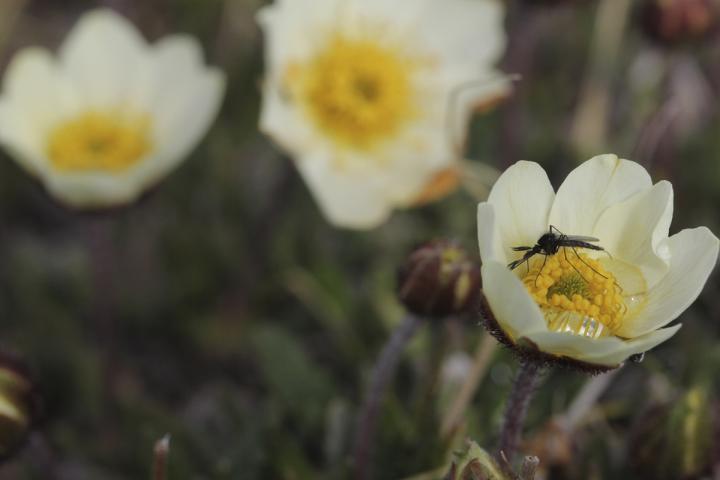Insect pollination is as important to Arctic plants as it is to plants further south. When flowers abound, the plants have to compete for pollinators. Researchers at the University of Helsinki reveal that higher temperatures cause the flowering periods of

Credit: Tuomas Kankaanpää.
Insect pollination is as important to Arctic plants as it is to plants further south. When flowers abound, the plants have to compete for pollinators. Researchers at the University of Helsinki reveal that higher temperatures cause the flowering periods of different plant species to pile up in time. As a consequence, climate change may affect the competitive relationships of plants.
The most attractive plant species steal the majority of pollinators, making other plants flowering at the same time suffer from poorer pollination.
“Most flowering plants are dependent on the pollination services provided by insects. Thus, plants need to time their flowering to periods of maximal pollinator abundances. On the other hand, plant species compete with each other for pollination. Thus, plant species flowering at the same time can affect each other’s pollination success. Temperature is one of the most important environmental determinants of the onset of flowering. As the climate warms, plant species change their flowering periods, thereby changing their competition for pollinators,” explains Mikko Tiusanen, researcher at the Faculty of Agriculture and Forestry, University of Helsinki, and lead scientist behind the study.
Avens is popular with pollinators – and competition is fierce
“We have been studying the relationship between plants and pollinators in North East Greenland, where the climate is warming twice as fast as the global average. The most common flowering plant in this region is Avens, a widespread and abundant flowering species. The shape of an Avens’ flower is an open, white cup of nectar, irresistibly attractive to any pollinators around. In our comparisons, Avens was found to attract many more visitors than other plant species. When in bloom, it thus monopolizes insect pollination services at the expense of other plants in flower,” says Tiusanen.
By studying the timing of flowering of different plant species under different environmental conditions, the researchers found that higher temperatures caused the flowering periods of different plant species to contract. In particular, the flowering of the Moss Campion advanced relative to the flowering of Avens. This affects the competition between the two species, since the flowering of Avens is directly reflected in how many insects carry Campion pollen: with more Avens in bloom, fewer insects carried the pollen of the Campion.
Global warming may thus affect competition between plant species for pollination services, thereby changing interactions between species. For example, overlap in flowering between a plant species and a more attractive competitor reduces pollination and may impair the species’ chances of survival in the long run. This is likely to be a particular threat to rare plant species, as well as to flower species less attractive to insects, scientists speculate.
“To me, the Arctic represents a planetary research laboratory for studies of climate change,” says Tomas Roslin, director of the research group spanning the University of Helsinki and the Swedish University of Agricultural Sciences (SLU). “The climate of this region is now changing twice as fast as the global average. What this means is that what happens in the Arctic today may later occur in the rest of the world. At the same time, relatively low species richness in the Arctic allows us to resolve their interactions in great detail. But scientific reasons are only half the arctic appeal. Northeast Greenland is one of the most beautiful areas in the world, and at the same time one of the largest uninhabited areas in the world. When studying insects here, you may even run into a polar bear. Such a combination keeps the researchers alert and awake.”
###
Media Contact
Mikko Tiusanen
[email protected]
Original Source
https:/
Related Journal Article
http://dx.




